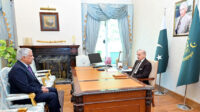Five senses: hearing, seeing, tasting, smelling and touching are blessings of the Almighty, which connects us to the world. Sound is all around us. Humans listen and respond. Expression of views is a fundamental right of all human beings. Noise attracts and alerts all living beings about potential dangers, music uplifts the spirit, laughter helps people bond, a crying infant alerts her mother about her needs.
Above all of this is language; the primary distinction between Man and Beast. Human language is capable of conveying complex ideas, intricate feelings, technical instructions and the primary medium for the transfer of knowledge beyond boundaries and time. It would be an understatement to say that “sound is important”. Yet if a blessing is ubiquitous in nature, it does become taken for granted. Enter the world of the deaf; a world of silence. In one sense, a unique world of its own, but practically cut off from society. Hearing loss can come in different varieties and intensities. From the mild hearing loss that essentially all of us may experience during a cold or with wax build up in our ears, to the severe birth related deafness that precludes any language acquisition by the child. Hearing loss by birth is one such handicap. But thanks to medical science which has reached pinnacles of development to overcome such health issues. Restoration of hearing loss of a child, born with this disability is, one such miracle of medical science. This procedure is called “cochlear implant”.
A Pragmatic Leader for a Progressive Pakistan: Shehbaz Sharif’s Strategic Approach
Upper floors of mosque demolished in Uttar Pradesh as Ramadan begins
“If you are really a good team….’: Saqlain’s open challenge to Team India
For more such Opinions & Blogs, click here.
A cochlear implant is an electronic device that improves hearing. It can be a choice for people who have severe hearing loss from inner-ear damage and can’t hear well with hearing aids. A cochlear implant sends sounds past the damaged part of the ear straight to the hearing nerve, called the cochlear nerve. For most people with hearing loss that involves the inner ear, the cochlear nerve works. But the nerve endings, called hair cells, in the part of the inner ear called the cochlea, are damaged. Cochlear implants use a sound processor that fits behind the ear and pulls in sounds from outside the ear. It sends sound signals to a receiver that’s been placed under the skin behind the ear.
The receiver sends the sound signals down an attached thin wire. The wire holds tiny sound electrodes that have been placed in the snail-shaped inner ear, called the cochlea.
The signals trigger the cochlear nerve. The nerve sends the signals to the brain. The brain hears those signals as sounds. These sounds are like natural hearing, but not quite the same.
It takes time and training to learn to hear the signals from a cochlear implant as words. Within 3 to 6 months of use, most people with cochlear implants make big gains in understanding speech.
US Spaceship Hours Away From Daring Moon Landing Attempt
Norway Firm Stops Fuel Supply To US Over Trump vs Zelensky
Partly cloudy weather with rain-wind, thunderstorm & snowfall over hills expected
March 3rd is designated by WHO as “World Hearing Day”; to raise awareness about hearing health, screening and testing of hearing disorders, prevention of deafness, and to implement hearing restoration strategies throughout the world. This is especially poignant for a country like Pakistan, where according to some studies (which may be underestimating due to scarcity of high-quality data) 1 out of every 1000 children born has some significant deafness. This would come down to more than a million deaf people in our entire population.
It is now possible that birth related deafness CAN BE TREATED. The treatment options, however, are time bound: if a deaf child is treated within the first 2 years of life, he may be able to develop listening and speaking skills at par with his peers, but beyond 5 years of age the hearing abilities are permanently stifled.Options for hearing restoration (depending on the cause) range from medication and hearing aids to Middle Ear surgery and Cochlear Implants.
A team of competent ENT specialists doctors at Foundation University, and its constituent hospital (Fauji Foundation Hospital) have carried out cochlear implants of over nearly 50 deaf children and changed their lives forever. These children have transcended from a silent world to a universe of sound, music, laughter and speech. These 50 children were fitted with cochlear implants in less than 6 months. As is expected, advanced technology is bound to be expensive (cost per patient is around Rs. 2.2 million) and as such beyond the capacity of an average Pakistani citizen. Ever ready to help the needy; Pakistan Bait ul Maal (PBM) has ensured that all 50 patients undergoing cochlear implant surgery were fully funded by the state. Furthermore, Foundation University, in collaboration with its Rehabilitation Medicine department has ensured that post implantation, these newly hearing children have access to highly quality speech therapy services, which ensures normal listening and speech skills are developed.
Death anniversary of poet Nasir Kazmi today
Champions Trophy: PCB announces full ticket refund for rain-cancelled matches
Several mega events organized in Balochistan
On 27th February 2025, a ceremony was conducted in Foundation University Medical College marking “A half century of Cochlear Implants”. The attendees were appraised about the condition of deaf children in Pakistan and the role Cochlear Implantation plays in restoration of hearing. Previously implanted children were brought on stage to showcase their-respective stages of progress with the implant (ranging from detection of sound, single word formation to recitation of Holy Quran and conversation with the chief guest). As some audience members later recounted; not only did they learn for the first time that childhood deafness could be treated, but the heart touching performance of newly hearing children almost brought tears to their eyes.
The SAMAAT program (which coordinates between Foundation University, various departments of Fauji Foundation Hospital and Pakistan Bait ul Maal for hearing screening, hearing restoration and cochlear implantation program) is a “Beacon Of Sound” for all hearing impaired patients and their families in the country.
For more such Opinions & Blogs, click here.
COAS underscores commitment to nurturing nation’s youth
Efforts underway for exploration of oil, gas reserves
New Polio case reported from Sindh
DPM , Danish FM discuss bilateral ties
This article is submitted by Dr. Sayed Nusrat Raza. The writer is an ENT specialist and head of department at Foundation University Medical College. He can be reached via email: sayed.nusrat@fui.edu.pk
Stay tuned to Baaghi TV for more. Download our app for the latest news, updates & interesting content!






